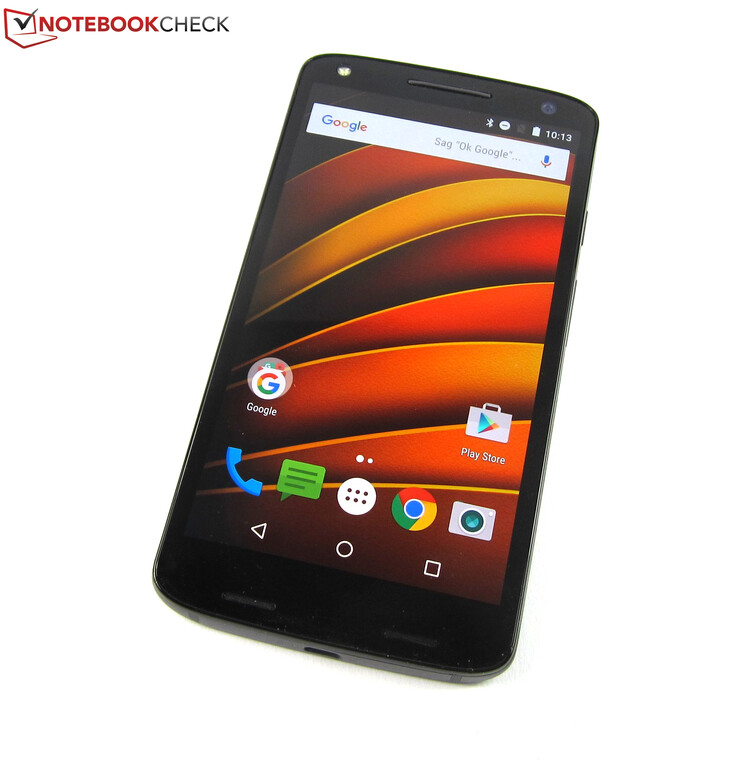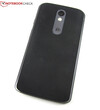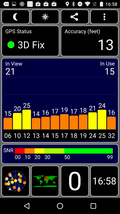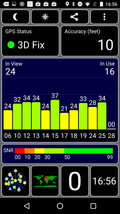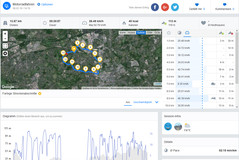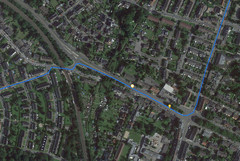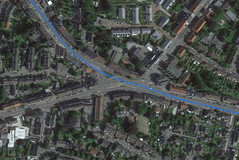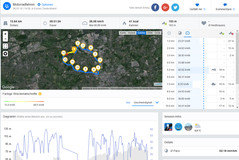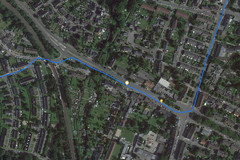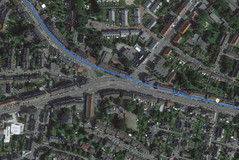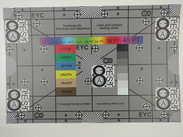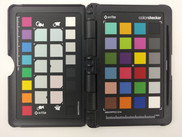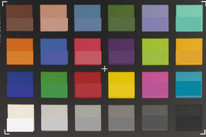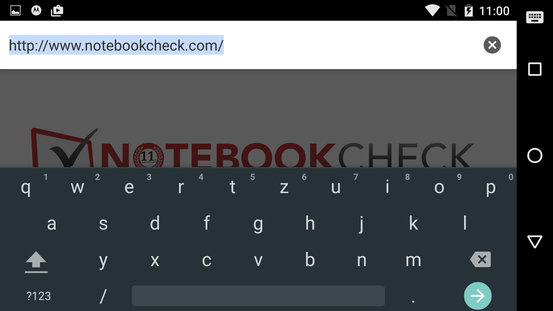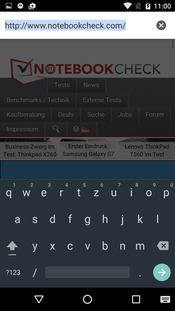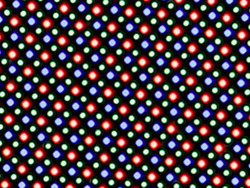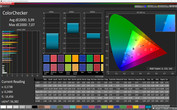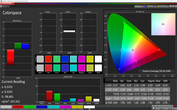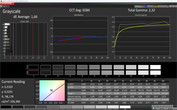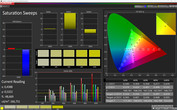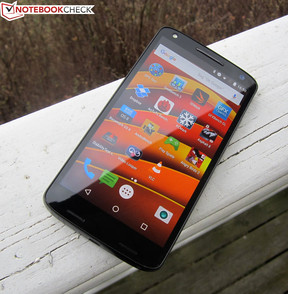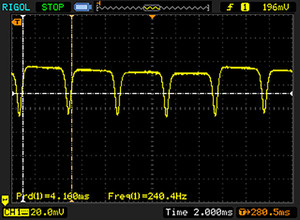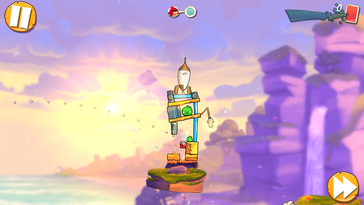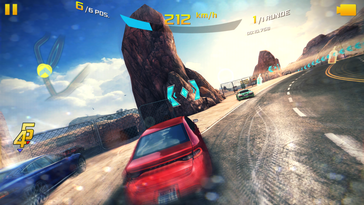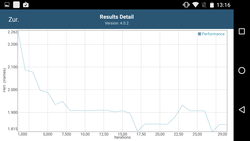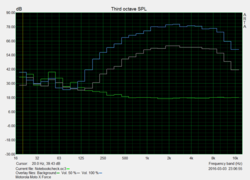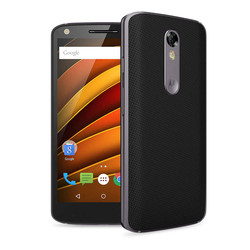Motorola Moto X Force Smartphone Review

For the original German review, see here.
It is hard to imagine life without a smartphone and it is almost a catastrophe when the loyal companion falls down in an unwary moment and shatters irreparably. A whole industry thrives from selling screen protectors, leather cases and security glass for preventing just that or to at least enable the handset to survive an accident. The robust, premium Motorola Moto X Force smartphone doesn't need any safety nets. It is the world's first device to feature ShatterShield, which is to most definitely prevent the screen from shattering or cracking according to the manufacturer. The Moto X Force even tolerates moments of wetness without damage thanks to its water-repelling nano finish.
Despite its toughness, the 5.4-inch Moto is not an unhandy, ruggedized brick. It is a 169 gram lightweight with a classy aluminum casing and decent configuration. The smartphone delivers high-performance with 3 GB of working memory, Qualcomm's Snapdragon 810 MSM8994 octa-core processor and Adreno 430 graphics unit as appropriate for its class. A screen with a resolution of 2560x1440 pixels, an enduring and quickly recharged battery, extensive communication equipment and a 21-megapixel primary camera that shoots outstanding pictures in daylight are also part of this bundle.
Since the Moto X Force plays in the smartphone premium league, it has to compete with equally strong rivals. We used the following smartphones, all with a similar configuration and size, for comparing the Motorola: Apple iPhone 6s, LG G4, Microsoft Lumia 950, Samsung Galaxy S7 and Sony Xperia Z5.
Case
Motorola manages to install a virtually "unbreakable" screen in its smartphone with a self-developed ShatterShield system. It is based on five panel layers. An aluminum bezel creates the first or the lower-most layer. The second layer is an AMOLED screen that is to lessen shocks with its flexible build. Then a double-layer of touchscreens follows - when one malfunctions, the second takes over. The outer-most and fifth layer is a foil made of an especially hard plastic, which is to prevent dents and signs of use. In case it does scratch or display other minor bruises, it can be removed and replaced with a new screen protector. However, its price of 30 Euros (~$33) in the manufacturer's online shop is not exactly cheap.
Despite its special build, the screen does not feel different than those of other standard smartphones. The screen is embedded seamlessly into the elegant and stiff aluminum chassis. Its handling is just as smooth as the physical power and volume controls on the handset. In conjunction with the slip-proof back (more about that below), it results in a very high-quality total impression. The only compromises involving the ShatterShield are its slightly higher weight than those of the comparison devices, and its thicker display bezel makes it a few millimeters wider.
Buyers can select between white/silver and black/gray color combinations for the Moto X Force's front and bezel. The casing's rounded back, which gives the smartphone a height of 9.2 millimeters in the tallest spot, is black "Ballistic Nylon" by standard. It is weaved nylon textile that provides the fingers with good grip. However, its rough surface texture will unlikely appeal to everyone and is also difficult to clean. The Moto X Force is also available with a "Soft Grip" back like the Moto X Play, and for 20 Euros (~$22) more it comes with grained leather. The back cannot be removed and consequently the battery cannot be replaced.
Two nano-SIM cards can be inserted in Motorola's smartphone simultaneously. However, since the second slot is a hybrid slot also for a micro-SD card, the user has to decide whether two nano-SIMs are to be used or a combination of one nano-SIM and one micro-SD.
Connectivity
Qualcomm's Snapdragon 810 MSM8994 high-end SoC powers the Moto X Force. Alongside the integrated Qualcomm Adreno 430 graphics unit and generous 3 GB of RAM, the fast octa-core processor smoothly renders all up-to-date Android applications and games. Approximately 23 GB of the 32 GB storage was available on our review sample ex-factory or after reset. Users who need more storage can take the 64 GB model of the Moto X Force. A reasonable 45 Euros (~$50) extra is charged for it in Motorola's online shop. The internal storage can also be expanded by up to 2 TB via the micro-SD slot, which is the technical limit for the SDXC standard. However, micro-SDXC cards with a capacity of over 128 GB are still very rare. 200 GB cards are sold sporadically.
Micro-SD cards can be integrated either as external storage or via Fusion storage so that the internal and external storage look like one big partition. Photos, data and selected apps can be moved between the internal storage and SD card as pleased.
Software
Android version 5.1 runs on the Moto X Force, but it can be updated to version 6.0 right away. The update warranty will also be continued by Lenovo since the brand Motorola will soon cease to exist. The manufacturer has barely modified the latest Android 6.0 compared with the original. Therefore, the offer of apps is largely limited to Google's standard apps like YouTube, Gmail, Chrome and Maps. Motorola supplements the software diversity by its smartphone manager "Connect" and the app "Moto" that turns the smartphone into a personal assistant via gesture and voice detection.
Communication & GPS
The Moto X Force supports GSM and UMTS pentaband and covers a total of 13 LTE channels. In terms of communication, the smartphone offers a very wide range and should also always find a way to connect to local mobile networks even abroad. The smartphone can automatically select the faster network when two SIM cards are inserted into the handset.
With Wi-Fi 802.11 a/b/g/n/ac, Bluetooth 4.1+LE and NFC, the Moto X Force is perfectly equipped for short-range data transfer. The reception was impeccable in both the 2.4 GHz and 5 GHz bands in the network, and always as fast as expected or as fast as the counterpart allowed. A signal was even received through three walls, although the strength dropped by up to 50% then. That also happened when moving more than 10 meters away from the router. Neither affected Internet browsing especially since there were no connection losses or other interruptions in the test.
The GPS reception is without reproach. It allows a very accurate localization indoors. The Moto X Force was even a bit better outdoors. The smartphone also improves that a bit more outdoors. The smartphone also maintained its high accuracy when we took it on our almost 14-kilometer test route along with our Garmin Edge 500 reference navigation device. The Moto X Force kept up well with the GPS navigation system and only deviated insignificantly in total. The difference between the two adds up to just 30 meters - it cannot get much better than that.
Telephone & Call Quality
The Moto X Force delivers a good call quality in both landlines and mobile networks. Our contact always understood us well thanks to the enabled noise suppression. The callers sometimes found voices sounded a bit stifled on both sides - other smartphones from the same performance league, such as Apple's iPhone 6s, do a better job. The phone app offers solid Android standards: A search box for names and numbers is present, and swiping left twice quickly opens the contact list.
Cameras & Multimedia
The 21-megapixel primary camera is one of the biggest strengths of the Moto X Force. The photos with a resolution of up to 5344x4008 pixels convince with very good color reproduction, have an exceptional richness in detail and they can easily compete with the very good camera lenses of an Apple iPhone 6s Plus or Samsung Galaxy S7 in good light. A light haziness covers the photos in less favorably illuminated scenes, which is only noticed negatively on some blowups. The lens with an aperture of f/2.0 is supported by a dual-LED flash with color correlated temperature. It can shoot panorama or HDR photos and adds GPS data when desired. Videos can be recorded in time lapse (720p) or at 30 FPS plus HDR in 1080p and 4K resolution of 3840x2160 pixels. The camera app does not offers manual settings for either the 21-megapixel primary camera or for the 5-megapixel webcam that also produces very appealing photos.
We compare a photo of X-Rite ColorChecker Passport taken in predefined light conditions with the factual reference color to check the color accuracy of Moto X Force's primary camera. The photo is not edited afterward. The direct comparison shows that the aberrations in color saturation are almost throughout kept within very tight limits. The Moto X Force tends to desaturate colors a bit only in the grayscale levels in total.
We photograph our test chart in controlled artificial light to evaluate the image sharpness. Especially the enlarged section of the photo's center shows that the Moto X Force reproduces all image areas clearly and can again indomitably compete with premium devices, such as Apple's iPhone 6s.
Accessories
The Moto X Force's box contains a power supply with micro-USB connector, a quick-start guide and a small tool for opening the nano-SIM/micro-SD slot. Neither a headset nor other accessories are included despite the high price of approximately 700 Euros (~$782). Both can only be purchased separately in the online shop. In addition to wireless in-ear headsets (80 Euros, ~$89), a power bank (50 Euros, ~$55) and replacement screen protectors (30 Euros, ~$33) are found here.
Warranty
Motorola includes a 4-year warranty on the ShatterShield and 2 years on the smartphone's other parts, which naturally excludes intentional damage or normal signs of use. However, how does the time-limited warranty on the screen fit to the allegation that it definitely will not break? To say it with Motorola's words: The smartphone is "not shatterproof nor has it been built to withstand all damage from dropping." The standards are set very high. The screen proved to be as tough as promised in the test. Drops from a table or on a hard ground did not affect the Moto X Force. The user should not overdo it with that, though. The smartphone might bruise when treated roughly.
Input Devices & Handling
Powered by an octa-core SoC, the Moto X Force responds extremely fast to inputs no matter if they are entered via the accurate touchscreen or the physical keys. Delays when swapping between menus, opening apps or other lags that would thwart smooth use were not observed in the test. The same is true for the virtual keyboard, which reserves half the screen in landscape and portrait mode, providing pleasantly sized keys. Content is not covered unnecessarily thanks to this half-height design, and the user always keeps the overview.
Display
Buyers looking for a smartphone with a great screen will find it in the Moto X Force. Motorola's handset reproduces the QHD resolution of 2560x1440 pixels on its 5.4-inch AMOLED panel. That equals an extremely high pixel density of 540 PPI, which makes it virtually impossible to see single pixels on the screen. Among the comparison devices, only Microsoft's Lumia 950 (564 PPI) and Samsung's Galaxy S7 (577 PPI) have an AMOLED alongside WQHD resolution, which even achieve a slightly higher pixel density than the Motorola.
With an average brightness of 335.6 cd/m², the Moto X Force seemingly lags behind a bit in the category comparison. However, its illumination of 91% is very homogeneous. When distributing bright and dark areas evenly (APL 50), the maximum brightness in the screen's center climbs from 337 to 381 cd/m². The maximum brightness even increases to 481 cd/m² when enabling the brightness sensor, which is quite close to premium smartphones like Apple's iPhone 6s (552 cd/m²).
The AMOLED panel produces a very deep black via inactive pixels. That in conjunction with the mathematically infinite contrast ratio leads to an impressive, very vivid color reproduction.
| |||||||||||||||||||||||||
Brightness Distribution: 91 %
Center on Battery: 337 cd/m²
Contrast: ∞:1 (Black: 0 cd/m²)
ΔE ColorChecker Calman: 3.99 | ∀{0.5-29.43 Ø4.79}
ΔE Greyscale Calman: 1.66 | ∀{0.09-98 Ø5}
Gamma: 2.32
CCT: 6584 K
| Motorola Moto X Force Adreno 430, 810 MSM8994, 32 GB eMMC Flash | Apple iPhone 6S A9 / PowerVR GT7600, A9, Apple AP0064K (iPhone NVMe) | LG G4 Adreno 418, 808 MSM8992, 32 GB eMMC Flash | Microsoft Lumia 950 Adreno 418, 808 MSM8992, 32 GB eMMC Flash | Samsung Galaxy S7 Mali-T880 MP12, Exynos 8890, 32 GB UFS 2.0 Flash | Sony Xperia Z5 Adreno 430, 810 MSM8994, 32 GB eMMC Flash | |
|---|---|---|---|---|---|---|
| Screen | -3% | -41% | -1% | 20% | -96% | |
| Brightness middle (cd/m²) | 337 | 552 64% | 566 68% | 292 -13% | 350 4% | 669 99% |
| Brightness (cd/m²) | 336 | 549 63% | 536 60% | 298 -11% | 351 4% | 624 86% |
| Brightness Distribution (%) | 91 | 87 -4% | 90 -1% | 92 1% | 98 8% | 85 -7% |
| Black Level * (cd/m²) | 0.39 | 0.47 | 0.68 | |||
| Colorchecker dE 2000 * | 3.99 | 3.4 15% | 6.17 -55% | 2.48 38% | 2.04 49% | 7.96 -99% |
| Colorchecker dE 2000 max. * | 7.07 | 3.25 54% | ||||
| Greyscale dE 2000 * | 1.66 | 4.16 -151% | 6.26 -277% | 1.97 -19% | 1.63 2% | 10.95 -560% |
| Gamma | 2.32 95% | 2.21 100% | 2.48 89% | 2.06 107% | 2.07 106% | 2.61 84% |
| CCT | 6584 99% | 7288 89% | 8171 80% | 6640 98% | 6391 102% | 7402 88% |
| Contrast (:1) | 1415 | 1204 | 984 | |||
| Color Space (Percent of AdobeRGB 1998) (%) | 62.18 | 65.48 | 86.86 | |||
| Color Space (Percent of sRGB) (%) | 95.93 | 98.63 | 99.35 |
* ... smaller is better
This subjective impression is confirmed when examining the AMOLED panel with the X-Rite i1Pro 2 X-spectrophotometer and CalMAN software. The Moto X Force displays the grayscale levels very well at a maximum DeltaE of 1.66. The gamma rate and color temperature are almost ideal. The DeltaE of 3.99 in mixed colors is a bit too high, but ultimately only the measurement tool notices that. This shift is invisible to the naked eye.
Screen Flickering / PWM (Pulse-Width Modulation)
| Screen flickering / PWM detected | 240.4 Hz | ||
The display backlight flickers at 240.4 Hz (worst case, e.g., utilizing PWM) . The frequency of 240.4 Hz is relatively low, so sensitive users will likely notice flickering and experience eyestrain at the stated brightness setting and below. In comparison: 53 % of all tested devices do not use PWM to dim the display. If PWM was detected, an average of 8167 (minimum: 5 - maximum: 343500) Hz was measured. | |||
Performance
High performance is a matter of course in a smartphone with flagship characteristics like the Moto X Force. The Moto X Force does not disappoint here. It provides high-end performance with Qualcomm's Snapdragon 810 MSM8994 high-end SoC, the fast Qualcomm Adreno 430 graphics chip, and the generous 3 GB of RAM. There is only one problem: The octa-core processor automatically throttles as soon as the casing's temperature exceeds a certain limit. The very good 89,911 points in AnTuTu 6 then quickly drops to 69,451 points when repeating the benchmark. We therefore took a longer break between every single test so that the smartphone could cool down again. Thus, these benchmarks represent the "best case" scenario - it cannot get better, only worse when the Snapdragon 810 SoC gets too warm. The octa-core processor is still extremely fast even in a throttled state despite this shortcoming.
The Moto X Force finishes the synthetic benchmarks faster than LG's G4 and Microsoft's Lumia 950 that are furnished with the somewhat weaker Snapdragon 808 SoC. It is tight between Motorola's smartphone and Sony's Xperia Z5 - sometimes the one handset is faster and then the other. However, the difference is not big. The Moto X Force does not stand a chance against Apple's iPhone 6s, not to mention Samsung's Galaxy S7. The Motorola only outruns all comparison devices in the PCMark for Android Work test scenario.
| 3DMark - 1280x720 offscreen Ice Storm Unlimited Score (sort by value) | |
| Motorola Moto X Force | |
| Apple iPhone 6S | |
| LG G4 | |
| Sony Xperia Z5 | |
| Samsung Galaxy S7 | |
| Geekbench 3 | |
| 32 Bit Single-Core Score (sort by value) | |
| LG G4 | |
| 32 Bit Multi-Core Score (sort by value) | |
| LG G4 | |
| GFXBench (DX / GLBenchmark) 2.7 | |
| T-Rex Onscreen (sort by value) | |
| Motorola Moto X Force | |
| Apple iPhone 6S | |
| LG G4 | |
| Microsoft Lumia 950 | |
| Sony Xperia Z5 | |
| Samsung Galaxy S7 | |
| 1920x1080 T-Rex Offscreen (sort by value) | |
| Motorola Moto X Force | |
| Apple iPhone 6S | |
| LG G4 | |
| Microsoft Lumia 950 | |
| Sony Xperia Z5 | |
| Samsung Galaxy S7 | |
| GFXBench 3.0 | |
| 1920x1080 1080p Manhattan Offscreen (sort by value) | |
| Motorola Moto X Force | |
| Apple iPhone 6S | |
| LG G4 | |
| Microsoft Lumia 950 | |
| Sony Xperia Z5 | |
| Samsung Galaxy S7 | |
| on screen Manhattan Onscreen OGL (sort by value) | |
| Motorola Moto X Force | |
| Apple iPhone 6S | |
| LG G4 | |
| Microsoft Lumia 950 | |
| Sony Xperia Z5 | |
| Samsung Galaxy S7 | |
| AnTuTu v6 - Total Score (sort by value) | |
| Motorola Moto X Force | |
| Samsung Galaxy S7 | |
| PCMark for Android - Work performance score (sort by value) | |
| Motorola Moto X Force | |
| LG G4 | |
| Sony Xperia Z5 | |
| Samsung Galaxy S7 | |
Almost the same is seen in the browser benchmarks: The Moto X Force passes the finishing line before LG's G4, Microsoft's Lumia 950, and this time also Sony's Xperia Z5. Apple's iPhone 6s and Samsung's Galaxy S7 play in their own league.
| Octane V2 - Total Score (sort by value) | |
| Motorola Moto X Force | |
| Apple iPhone 6S | |
| LG G4 | |
| Microsoft Lumia 950 | |
| Sony Xperia Z5 | |
| Samsung Galaxy S7 | |
| Mozilla Kraken 1.1 - Total (sort by value) | |
| Motorola Moto X Force | |
| Apple iPhone 6S | |
| LG G4 | |
| Microsoft Lumia 950 | |
| Sony Xperia Z5 | |
| Samsung Galaxy S7 | |
| WebXPRT 2015 - Overall (sort by value) | |
| Motorola Moto X Force | |
| Apple iPhone 6S | |
| LG G4 | |
| Microsoft Lumia 950 | |
| Sony Xperia Z5 | |
| Samsung Galaxy S7 | |
| JetStream 1.1 - Total Score (sort by value) | |
| Motorola Moto X Force | |
| Apple iPhone 6S | |
| LG G4 | |
| Microsoft Lumia 950 | |
| Sony Xperia Z5 | |
| Samsung Galaxy S7 | |
* ... smaller is better
The Moto X Force shows its strength in data transfer and places itself in front of LG's G4 and Sony's Xperia Z5 in random read and write with one exception. Motorola's handset presents its biggest weakness in sequential write. With 48 MB/s, it lags far behind the rivals that are two or three times faster. This outcome does not change after multiple runs and reboots. The Samsung Galaxy S7's tremendous data rate is impressive in all benchmarks.
Using our 32 GB Toshiba Exceria Pro M401 (model: THN-M401S0640E2; read max.: 95 MB/s; write max.: 80 MB/s), we see that the micro-SD performance of the Moto X Force is also only average. The smartphone clearly remains behind the maximum rates with 79 MB/s in sequential read and 47 MB/s in sequential write.
| AndroBench 3-5 | |
| Sequential Read 256KB (sort by value) | |
| Motorola Moto X Force | |
| LG G4 | |
| Sony Xperia Z5 | |
| Samsung Galaxy S7 | |
| Sequential Write 256KB (sort by value) | |
| Motorola Moto X Force | |
| LG G4 | |
| Sony Xperia Z5 | |
| Samsung Galaxy S7 | |
| Random Read 4KB (sort by value) | |
| Motorola Moto X Force | |
| LG G4 | |
| Sony Xperia Z5 | |
| Samsung Galaxy S7 | |
| Random Write 4KB (sort by value) | |
| Motorola Moto X Force | |
| LG G4 | |
| Sony Xperia Z5 | |
| Samsung Galaxy S7 | |
Games
The hardware requirements of current Android games are absolutely no challenge for the Moto X Force. All games we installed for testing, such as Asphalt 8: Airborne and Angry Birds 2, ran in full details and absolutely lag-free. The accurate touchscreen and good gyro sensor also contribute to gaming fun.
Emissions
Temperature
The Moto X Force barely heats up in idle mode with a maximum of 31.3 °C. The smartphone is also within a good range during load with a peak rate of 40.4 °C. A typical problem of the Snapdragon 810 SoC is seen in the stress test using GFXBench: Throttling at too high temperatures. The initially high performance soon caves in and stays at a clearly lower level over the entire test. However, the performance of Qualcomm Snapdragon 810 MSM8994 and the Adreno 430 GPU is still easily enough for gaming and all common applications despite this throttling.
(+) The maximum temperature on the upper side is 39.8 °C / 104 F, compared to the average of 35.2 °C / 95 F, ranging from 21.9 to 247 °C for the class Smartphone.
(±) The bottom heats up to a maximum of 40.4 °C / 105 F, compared to the average of 34 °C / 93 F
(+) In idle usage, the average temperature for the upper side is 30.8 °C / 87 F, compared to the device average of 32.9 °C / 91 F.
Speaker
The speaker in the Moto X Force is situated on the smartphone's lower edge over the micro-USB port. Although it looks like two speakers are installed, the microphone is under the left opening. That is noticed at latest when a finger covers the right opening and hardly anything or nothing is heard. The mono speaker does not distort at its maximum volume of 89.2 dB. It, however, produces a relatively thin sound with inaudible mids and low tones. The sound measurements also confirm that. The Moto X Force only manages low dB rates in the low tone range (left frequency range in the graph). Thus, these frequencies are completely covered by the much louder high tones. Unfortunately, an equalizer app is just as absent as a headset, which Motorola only offers for a surcharge in its online shop.
Energy Management
Power Consumption
The Moto X Force has the best preconditions for a long battery life with its 3760 mAh battery, although its power consumption is slightly above the average in some cases. The smartphone consumes an average of 1.35 watts in idle mode, and it can climb up to 9.4 watts during full load. Only Samsung's Galaxy S7 has a slightly stronger battery among the comparison devices (3600 mAh). LG's G4 and Microsoft's Lumia 950 both have a 3000 mAh battery.
The Moto X Force supports the Qi standard and can be recharged via a corresponding charging station without a cable. Fast Charge is also supported and truly earns its name here. The smartphone's battery is recharged by 25% after only roughly 15 minutes at the outlet. A completely depleted battery was fully recharged in approximately 1 hour and 20 minutes in the test.
| Off / Standby | |
| Idle | |
| Load |
|
Key:
min: | |
Battery Runtime
The Moto X Force is throughout convincing in battery life - it should even be enough for a whole day of intense gaming without need for recharging. Although Apple's iPhone 6s and Sony's Xperia Z5 marginally defeat the smartphone in the real-world Wi-Fi test, its time of 7 hours and 6 minutes is very good. The Moto X Force lasts the longest in the video test with adapted brightness and disabled Wi-Fi module, and it even surpasses the long-running Apple with 11:50 hours.
| Motorola Moto X Force Adreno 430, 810 MSM8994, 32 GB eMMC Flash | Apple iPhone 6S A9 / PowerVR GT7600, A9, Apple AP0064K (iPhone NVMe) | LG G4 Adreno 418, 808 MSM8992, 32 GB eMMC Flash | Microsoft Lumia 950 Adreno 418, 808 MSM8992, 32 GB eMMC Flash | Samsung Galaxy S7 Mali-T880 MP12, Exynos 8890, 32 GB UFS 2.0 Flash | Sony Xperia Z5 Adreno 430, 810 MSM8994, 32 GB eMMC Flash | |
|---|---|---|---|---|---|---|
| Battery runtime | -13% | -29% | -28% | 5% | -11% | |
| Reader / Idle (h) | 26.8 | 25.2 -6% | 27.6 3% | 25 -7% | 30.2 13% | 27.8 4% |
| H.264 (h) | 11.8 | 11.7 -1% | 8.4 -29% | 9.5 -19% | 14.9 26% | 10 -15% |
| WiFi v1.3 (h) | 7.1 | 8.2 15% | 5.4 -24% | 4.2 -41% | 7.6 7% | 7.3 3% |
| Load (h) | 5.5 | 2.3 -58% | 1.9 -65% | 3.1 -44% | 4 -27% | 3.6 -35% |
Pros
Cons
Verdict
Motorola has hit a home run with its Moto X Force. That can even be taken literally on the one hand because the 5.4-inch Android is furnished with an unbreakable screen. On the other, the Moto X Force should not be reduced to its toughness. The premium-range smartphone brings along a whole range of further advantages. The bright and viewing-angle stable AMOLED screen, which reproduces razor-sharp content thanks to its high resolution of 2560x1440 pixels and the tremendous pixel density of 540 PPI, definitely counts to that. Other highlights are found in the powerful Snapdragon 810 MSM8994 octa-core SoC, the well-equipped communication module that does not leave anything to be desired with Wi-Fi 802.11 ac over LTE, NFC and two SIM slots. More plus points: The elegant metal chassis, the latest Android 6.0, an excellent 21-megapixel camera, long battery runtimes and the Fast Charge feature.
The Moto X Force features an actually long overdue feature: An unbreakable screen that withstands drops on a stone floor without damage.
Although Motorola demands almost 700 Euros (~$782) for its smartphone, a headset is not included and has to be purchased separately. The sound could also be better since only a mono speaker is installed in the Moto X Force. Finally, Motorola also has to accept criticism for the choice of the SoC. The processor throttles as soon as it reaches a certain temperature. However, its performance is easily enough for all current Android applications and games even in a throttled state.
Motorola Moto X Force
- 04/21/2016 v5.1 (old)
Manuel Masiero




